15 ways to clean the hood in the kitchen from fat at home
Doctors say it’s better to prevent the disease than to treat it. This rule applies to some household appliances. Cooker hood daily captures a huge amount of fat and odors, which is why its filters are covered with a layer of sticky coating. If you tighten with cleaning, then putting the hood in order will then be very difficult. It is better to regularly clean the device, remove fresh plaque immediately after cooking, and unpleasant consequences can be avoided. But we will be honest with ourselves: not everyone is washing inlet filters a couple of times a month. Therefore, when the hands reach them, one can be horrified by the opening view. But everything is fixable! There are lots of effective ways to clean the hood in the kitchen from grease at home, and some methods are designed for serious pollution.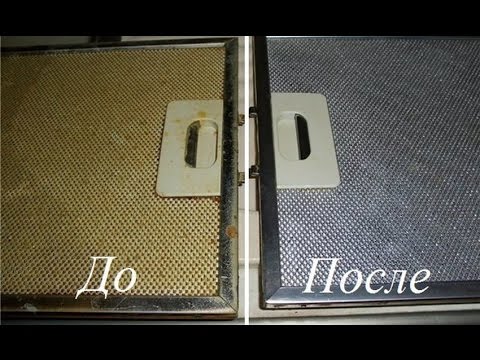
How often do you need to clean the hood?
First, a little theory. Ideally, you should clean the hood once a month - this is with an average activity of kitchen processes. If the family is large, and often have to fry, soar, then it is better to clean the filters once a couple of weeks. With not very high activity in the kitchen, you can reduce the frequency of cleaning up to every 2-3 months. If you follow this rule, then each cleaning will take a minimum of time, because fresh plaque is removed without undue effort.
What will happen if you do not clean the hood in time? Here are the main consequences:
- decreased effectiveness of the main function - a clogged filter does not catch dirt and grease so well, so the degree of air purification in the kitchen will gradually decrease;
- increase in noise level;
- deterioration of the appearance of the hood, because not only the inside, but also the body suffer from fat;
- complete failure.
Once every 1.5-2 years, it is recommended to completely disassemble the hood and lubricate the motor.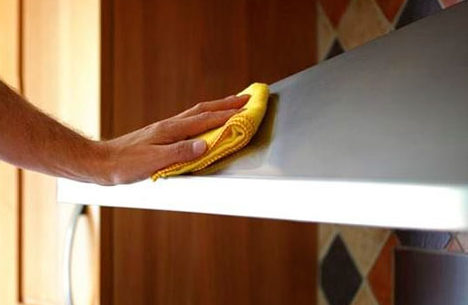
What do you need to know before cleaning?
Just wipe the outer part of the body with buttons - this does not mean washing the hood. The device will have to be partially disassembled, and in order to do this correctly, it will be necessary to look into the instructions, which indicate all the nuances of the design and disassembly rules for specific model. In outline the process of preparing the hood for cleaning is as follows:
- disconnect the device;
- snap off the latches of the upper panel (if any) and remove the grease filter. It captures fat particles well, does not need to be replaced - only regular cleaning. The grease filter is usually made of steel or aluminum.. The steel option is the best. There are disposable grease filters that are used in the most compact range hoods. They are made on the basis of paper, acrylic, sintepon or non-woven, and need to be replaced every 3-4 months, they can not be washed;
- remove the charcoal filter, which is equipped with circulation-type hoods. The carbon filter cannot be washed - it needs to be replaced as it becomes dirty. On average, it is changed every 4-6 months.

Flow hoods drawn air is drawn out through the ventilation duct to the street. A grease filter is necessary to protect the motor. In this type of extractor hood, the ventilation duct is sometimes required to be cleaned. Circulation hoods they draw in air, clean it and send it back to the kitchen. The cleaner the carbon filter, the more efficient the process, so remember to change it.
How and how to clean the hood in the kitchen from grease? It all depends on the degree and age of pollution. Someone will do a little blood, i.e. the most common detergents, and someone will have to sweat using aggressive chemicals.
Method number 1. Any dishwashing detergent
If the fat has not yet had time to eat into the holes on the grease filter and solidify firmly, has not acquired a sticky consistency and dark color, then the usual dishwashing detergent, which is in every home, will help.
Procedure:
- find the container where the removed grease filters (bucket, baking sheet, basin) will fit comfortably;
- put the filters in a container, apply dishwashing liquid on them;
- pour hot water so that the filters are completely under it;
- leave for 30-40 minutes;
- remove the filters and treat each with a metal sponge or brush, trying to get rid of all the softened fat;
- if it was not possible to remove all the fat the first time, repeat the procedure. If the second time the fat is in no hurry to part with the surface of the filter, then we should move on to more serious methods;
- soapy residues are thoroughly washed off with water;
- before installing back on the hood, the filters are completely dried;
- aluminum grilles are too long not to be kept in water for too long.
Like method is great for washing the hood regularly. If you repeat this washing once a month after purchasing the device, then you will not need more aggressive and sophisticated cleaning methods.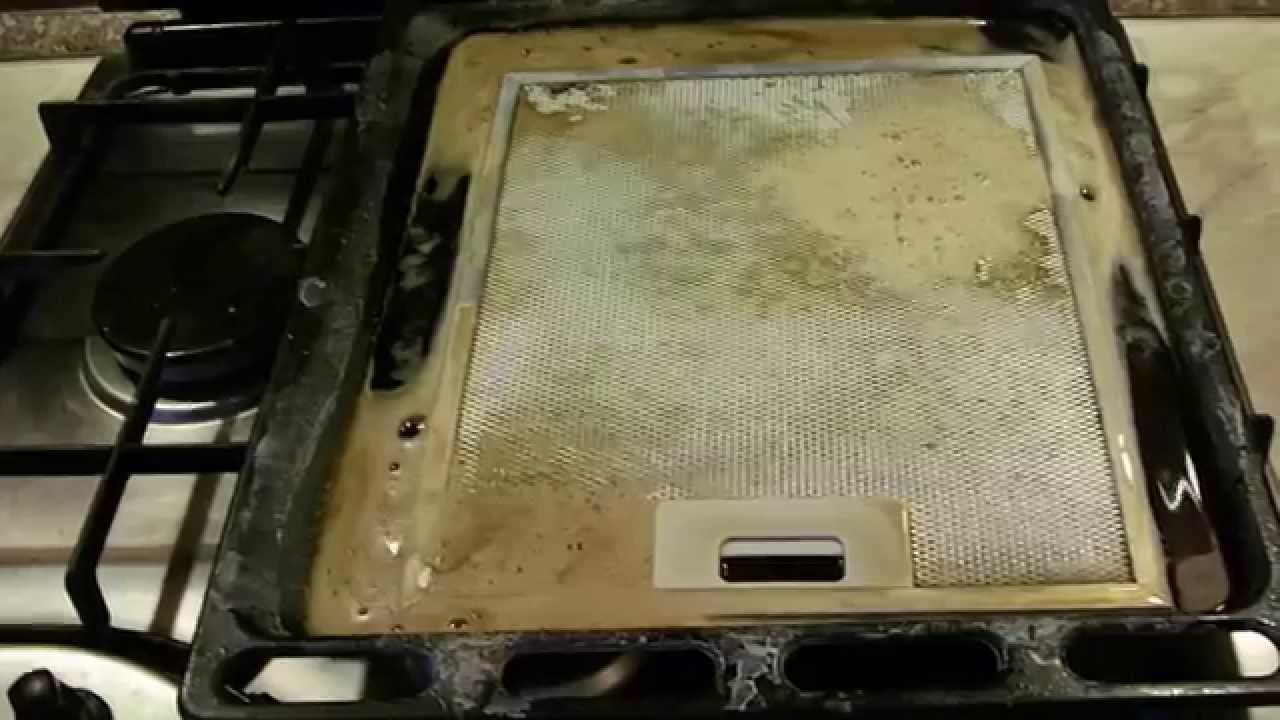
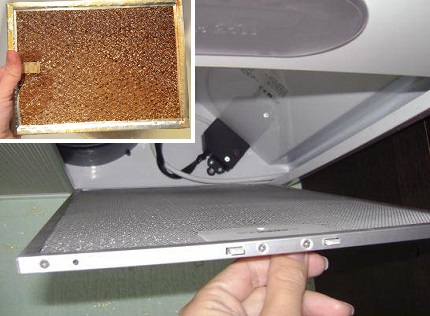
Method number 2. Soda Cleaning
Option for hoods light to medium pollution, as well as an alternative for those who do not respect household chemicals. Take better soda ash, it works somewhat more efficiently than baking soda.
Procedure:
- a large capacity is filled with water and put on fire;
- while the water is warming, a little soda is added to it (only half a glass per 10 liters of water). The solution is constantly stirred;
- when the solution boils, dip the filters and boil for 30 minutes;
- if there is no container where the filter fits completely, first one part of the grid is boiled, then it is turned over and the procedure repeated;
- after cooking, the fat is easily removed with a brush. It remains only to rinse the filter.
The method is better suited for steel gratings, as aluminum can become dull with prolonged contact with soda.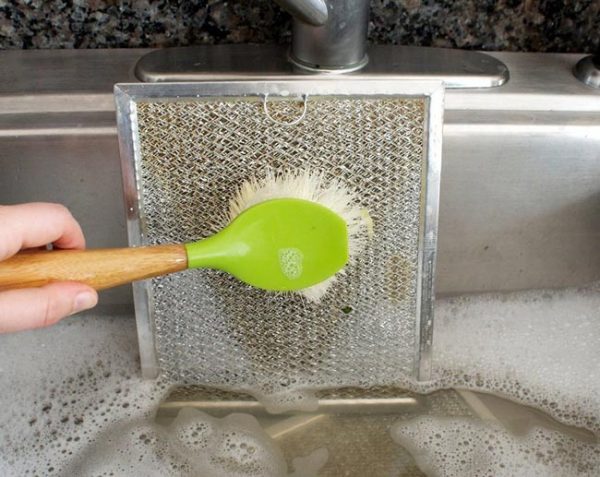
Method number 3. Soapy soda solution
This method is a mix of the two previous ones, so its efficiency is higher. If you carefully read the instructions for the hood, then in 99% of cases there will be a manufacturer's recommendation that only soap solution be used for cleaning, because this is the most gentle way. Alas, it does not always help. You can enhance its effect with ordinary soda.
Procedure:
- hot water is poured into the container;
- add 1/4 cup baking soda and a tablespoon of dishwashing liquid to the water. Mix with a large spoon, spatula or any other improvised means (most importantly, not by hand);
- grease filters are put in the solution for 10-20 minutes;
- further, as in the previous case: rub with a brush, rinse well.
This method gives results almost always, with the exception of cases where the hood has not been washed for several years. You can increase the effectiveness of the method by boiling for 5-10 minutes. If the case is running, then bring the water with filters to a boil, and then "simmer" over low heat for 1.5-2 hours. Only steel filters can pass this test.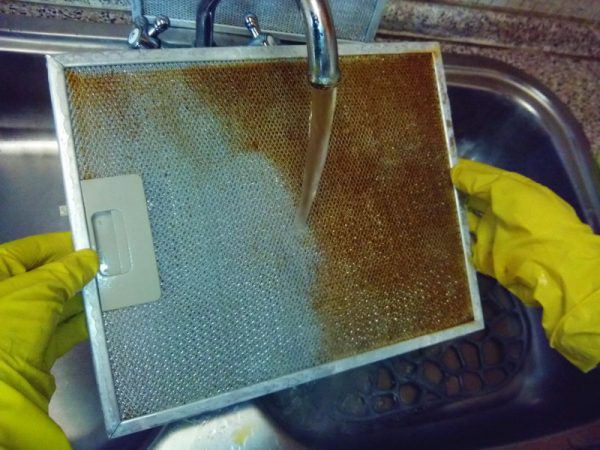
Method number 4. Laundry soap and soda
Based on soda, soap and detergents, we came up with a lot of recipes for cleaning anything. We consider it necessary to mention all the most popular and effective methods. A solution of laundry soap and soda helps to get rid of even fat that has gotten into the filter.
Procedure:
- grate 100 g of 72% laundry soap on a grater, cook 5 tbsp. tablespoons of soda and dissolve all this in 10 liters of hot water;
- the filters are lowered into the solution and boiled for 10-15 minutes, in the presence of old fat, the boiling time can be increased to 30 minutes;
- softened dirt is rubbed with a brush, the filter is washed well with water;
- you can add a grated apple to the solution - acid will help to quickly deal with dirt.

Some housewives use only laundry soap: cut a half of the bar or tinder, dissolve in 3 l of water, and the filter is kept in the resulting solution for 20-30 minutes.
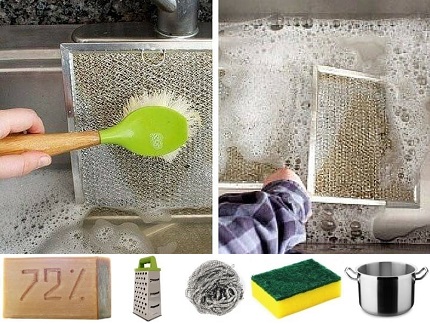
Method number 5. Ammonia
Ammonia is in almost every medicine cabinet. The tool copes well with fat, especially if it has not yet had time to firmly stick to the filter.
Procedure:
- protect the airways, provide good ventilation of the room, i.e. open all possible windows, and it is better to close the doors to other rooms;
- in 3.5 liters of warm water (temperature 500C) dissolve 100 ml of ammonia;
- leave for 2-4 hours;
- it remains to remove the grease with a brush and rinse the grate.

Method number 6. Vinegar cleaning
Every housewife knows that soda and vinegar are unique means for cleaning anything. The main thing is that there is no harm to their health, and they are always in the house.
Procedure:
- open the window and put on gloves;
- moisten a sponge or rag in 9% vinegar solution, thoroughly wipe all dirty places. You can place the filter in a baking sheet and pour in vinegar;
- leave for 10-15 minutes;
- brush, rinse thoroughly.
Serious impurities may not be able to cope with a 9% vinegar solution. If your case is running, it is better to take undiluted food acetic acid (70%). For medium soiling, a 70% solution can be diluted with 1: 1 water.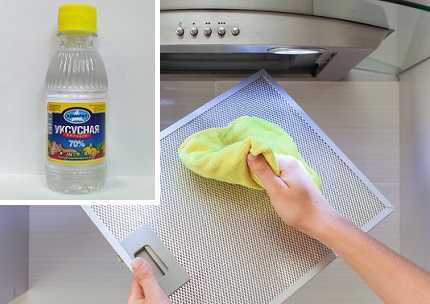
Method number 7. Lemon juice cleaning
If acetic acid can corrode fat, then why not use other acids used in everyday life. For example, citric acid.
Procedure:
- 1-2 lemons are peeled, cut into halves and rubbed with a dirty filter. In the absence of lemons, citric acid is used (3 tbsp.spoons per 1 liter of water);
- leave for 20 minutes, in case of severe pollution it is better to soak the filter in a solution of citric acid and leave for several hours or all night;
- clean, rinse and dry the filter.

Method number 8. Combined Detergent
If soda, soap, vinegar, ammonia and citric acid so well cope with fat, then why not combine them to get the fastest and highest quality result?
Procedure:
- dissolve in 5 l of water for 1-2 tbsp. tablespoons of soda, citric acid and salt, half a bottle of peroxide, ammonia and silicate glue, half a tablespoon of vinegar and ethyl alcohol, and half a bar of previously grated laundry soap;
- filters are placed in the heated solution and left for 1-2 hours, so that the fat is well-softened;
- fat is removed with minimal effort.

Method number 9. Mustard powder
This is one of the oldest, the so-called grandmothers ways, but some housewives use it to this day.
Procedure:
- to 3.5 tbsp. l mustard powder add 2 tsp shampoo, mix and pour in a pre-prepared solution of hot water and vinegar, mixed 1: 1. Mix everything thoroughly, so that in the end it will get the consistency of a liquid slurry;
- moisten the filter under a stream of warm water;
- process the filter mixture on both sides;
- wrap with a towel dipped in hot water and leave for 30-40 minutes;
- remove softened fat with a brush, rinse the filter.

Method number 10. Carbonated drinks
Acids are also found in beverages such as Pepsi and Coca-Cola.If you do not mind spending a bottle of soda to clean the exhaust grilles, you can see for yourself the effectiveness of the product. The principle of operation is the same: fill the filters in the container with a drink, leave for a longer time, and then easily remove the dirt.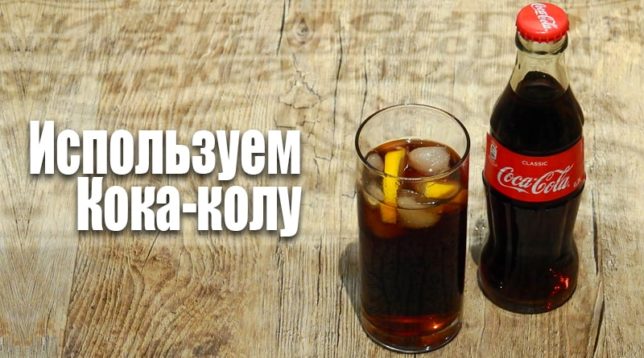
Method number 11. White
Often, whiteness is used when cleaning the hood of the hood from grease, but it will cope with filters, however, it is unlikely that it can clean up serious dirt.
Procedure:
- wet the filters;
- with a toothbrush, apply whiteness to the filter for 10-15 minutes;
- remove grease with a brush and rinse the filter.

Method number 12. Special tool for cooker hoods and ovens
One of the easiest and most effective ways to clean the hood from fat is to take a special tool designed to dissolve fat deposits in the oven, Microwave ovens and cooker hoods (for example, “1 minute” spray from Sanita, “Shumanit” from Bugs, gel and Anti-Fat + Shine spray from Cilit Bang, Anti-Fat spray from Cinderella, Synergetic gel). These substances are quite aggressive, so the respiratory tract should be protected, and rubber gloves should be put on your hands.
Procedure:
- put filters in a container;
- to put means on a lattice. If the consistency of the product is gel-like, then it is better to evenly distribute it with a sponge;
- Leave on for 30 minutes, unless otherwise stated in the instructions. For example, some manufacturers recommend putting the filter in a bag for only 10-15 minutes after applying the product to prevent the spread of pungent odor;
- It remains to remove softened dirt with a sponge or brush, and then rinse with warm water.
The disadvantage of the method is the high cost of special tools. In addition, the option is not suitable for those who negatively relate to aggressive household chemicals and prefer to use alternative recipes. If you stopped on this particular method, it’s very carefully read the instructions on the packaging of the product. Some formulations are not suitable for aluminum grilles.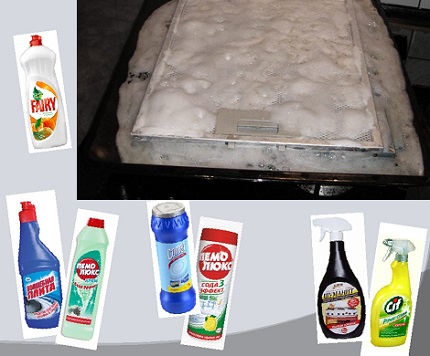
Method number 13. Pipe cleanser
If the filters have not been washed for a long time, then the fat is most likely stuck to the metal so that you cannot take it by any of the methods described above. Then heavy artillery enters the battle - the means by which usually sewer pipes are cleaned from blockages (for example, "Mole", "Tyreth", "Steril"). They usually include sodium hydroxide, which does an excellent job with old plaque. On the other hand, alkali must be handled with extreme caution, so at least gloves should be stocked.
Procedure:
- carefully read the instructions on the package, especially the section on safety;
- place the filters in a container or baking sheet, pour in the purchased product so that the grids are completely covered. If the product was sold in granules or powder, then the filters must be filled up, and then filled with hot water;
- leave for 5-10 minutes, during which the fat dissolution reaction will take place with the formation of a dirty foam;
- you don’t have to rub anything, the fat will completely dissolve, all that remains is to rinse the filter with water.
The tool for blockages is a very aggressive chemistry, so often it is better not to use this method of cleaning, or rather, it is better not to bring the hood to a state where only this method saves. It is recommended to carry out such cleaning no more than 1-2 times for the entire life of the hood. It should be especially careful with aluminum filters.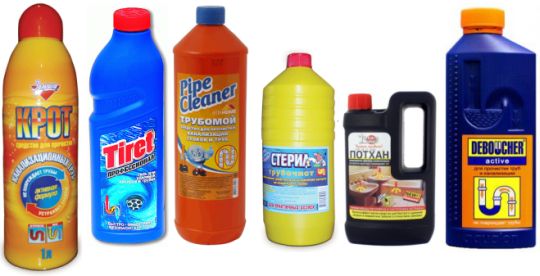
Method number 14. Steam generator
The option is not for everyone, since not every apartment has a steam generator. This appliance produces steam with a temperature of around 1500C, which allows you to literally melt all the fat. Moreover, the surface of the filters is disinfected. After treatment with a steam generator, it is enough to wash the filters in warm water and rub them with a sponge with detergent or liquid soap - the fat will leave very quickly.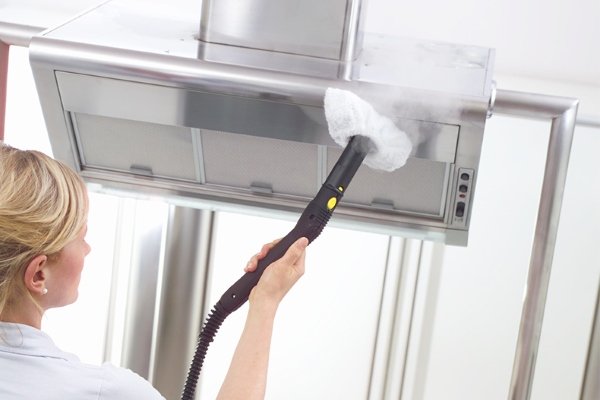
Method number 15. Dishwasher safe
The easiest way that does not require temporary and physical efforts from the hostess.It is enough to remove the filter, put in dishwasher and go do your own thing. There is debate about the effectiveness of this method, and many prove its absolute inaction. These people are partly right. If you put in the dishwasher a filter with old adhering grease, then you will get exactly the same dirty filter. The way with the dishwasher suitable for regular filter cleaning. If you clean twice a month, then other methods can not be resorted to, or resorted to very rarely.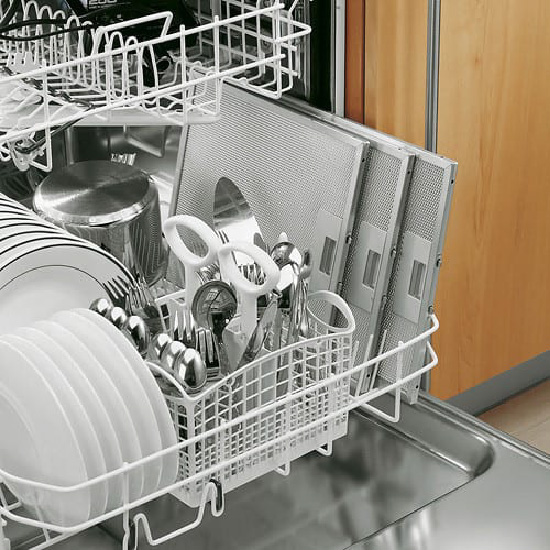
How to clean the hood housing?
Any housewife wipes the outer part of the hood much more often than washing the hood filters, so that a layer of dirt does not accumulate there. You can remove plaque with a regular dish detergent. It is applied to a damp sponge, foamed and a dome wiped with a sponge. You can leave the foam for a few minutes, after which it is carefully removed with a damp cloth, and then the hood hood is wiped dry. Probably, this simple way is familiar to every housewife. You can replace the detergent with window cleaning fluid - it dissolves plaque well and gives the surface a shine.
If for some time the hood body did not see proper care, then the following methods will come in handy:
- means for washing ovens, range hoods and microwave in the form of a spray or liquid;
- a mixture of soda ash (3 tablespoons), silicate glue (100 ml) and washing powder (0.5 tablespoons), which are dissolved in a glass of warm water. After thorough mixing (you can in a plastic bottle to shake well), the product is applied to the surface, you can leave it for 5-7 minutes, and then remove the composition along with the dirt lagging behind the body. The tool helps even in advanced cases;
- half of the lemon to grate the surface, leave for a while, then rinse the juice with a damp sponge.
Abrasive detergents and hard brushes are best avoided so as not to scratch the surface. If there is severe pollution, you can separate them with a plastic scraper.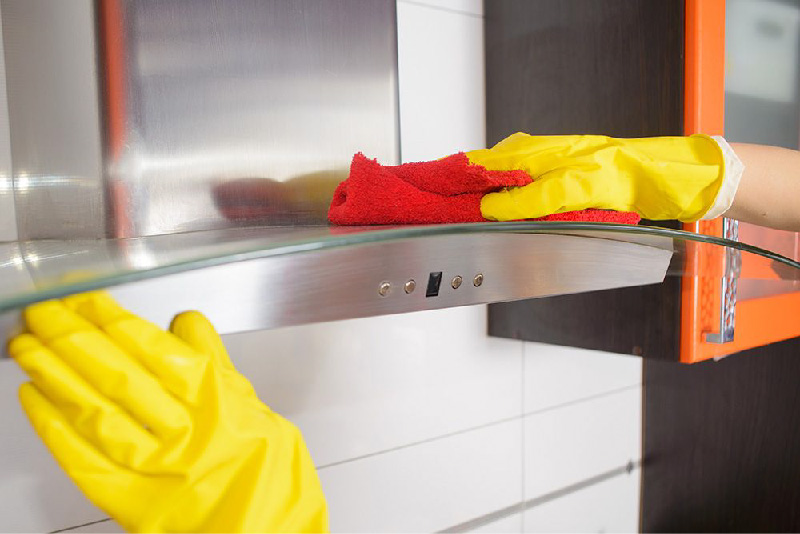
How to clean the hood buttons?
The buttons on the hood are pressed several times a day, often with dirty hands during cooking. Naturally, fat also accumulates on them. To remove it, you can use ammonia. They gently wipe the buttons using a cotton pad or ear sticks. You may need to rub a little with a toothbrush, but very carefully so as not to leave scratches. In addition to ammonia, anise drops, nail polish remover and hydrogen peroxide will do.
How to clean the inside of the hood?
Not so intensively, but fat also accumulates on the inner walls of the hood, so that periodically you will have to clean up there too. You can use all the same means as for cleaning the outer part of the case. If there is so much fat that you can’t take it, then use the radical option - a pipe cleaner. Only then it will need to be washed off very carefully.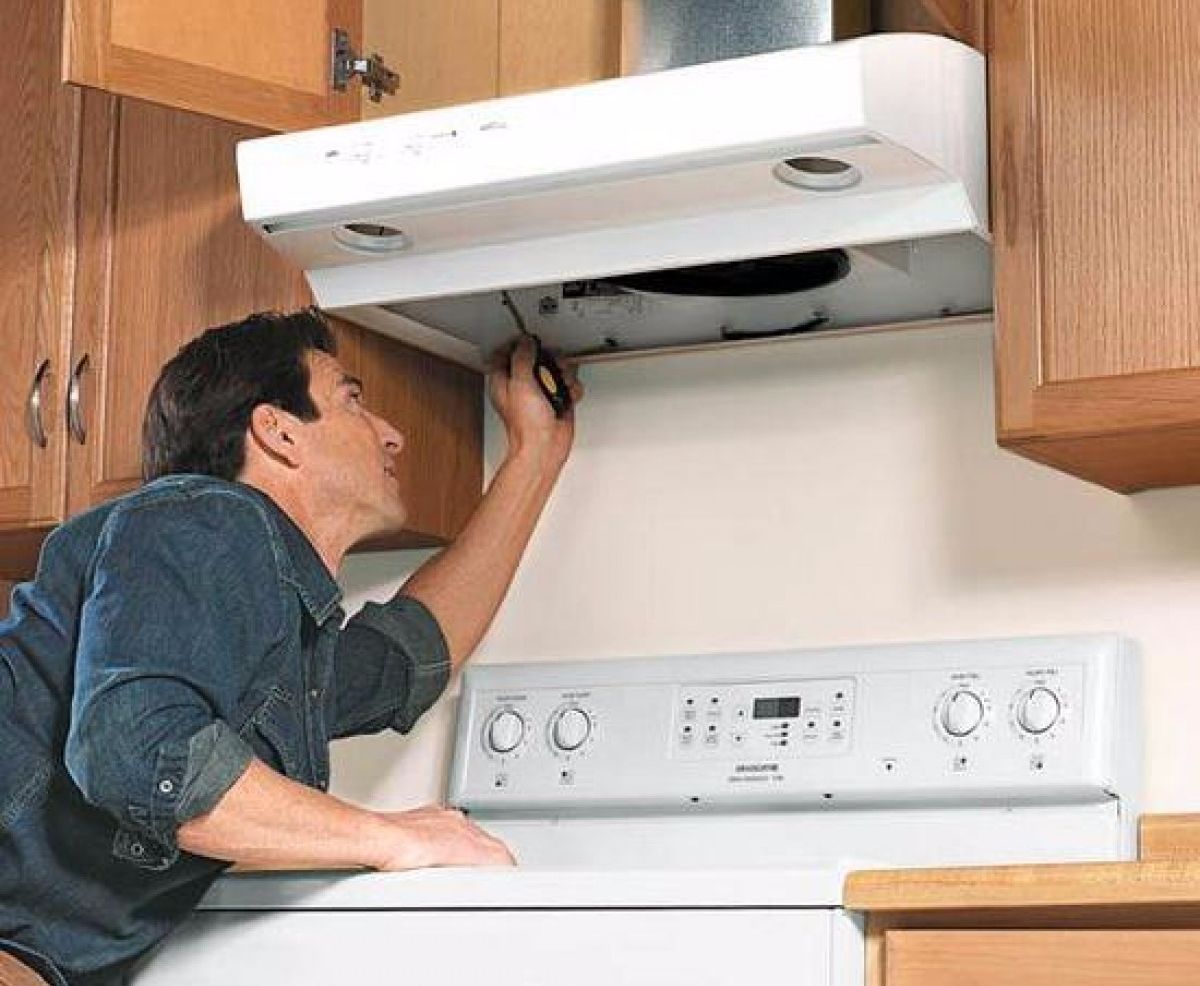
How to clean the duct?
The item is relevant for owners of flow hoods. Evidence that fat has accumulated in the duct can be reduced traction. Even if everything is in order with the draft, once a year or two the condition of the duct will not hurt to check.
Ducts are:
- round or square plastic;
- round corrugated aluminum.
The first consists of several parts, are easily disassembled. It is enough to wash them with soapy water and rinse thoroughly. They are easy to clean.
Corrugated pipes are cheaper, they are used more often, but they collect fat much better. Fat settles and accumulates in numerous folds. It is often easier to replace the pipe than to clean it. If the house has a steam cleaner, then use it. In extreme cases, the pipe can be cleaned with “Mole” or a similar tool, but it will need to be washed very carefully.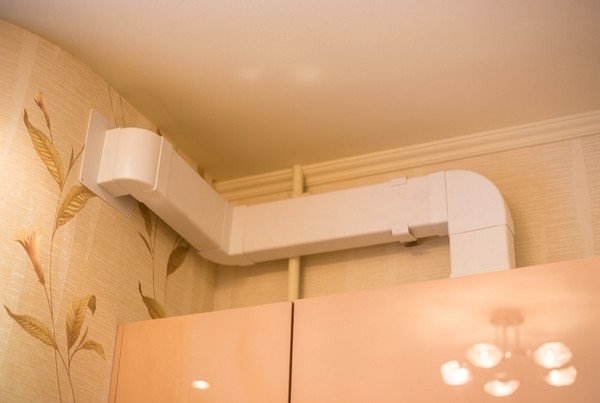
How to clean the fan and motor?
It is necessary to clean them once every 1-2 years, it is better to study the instructions for the hood in order to understand where the elements are located and how they are attached. After the filters are removed, unscrew the fixing bolts, remove the fan and motor, and then disconnect the fan from the motor. The impeller of the fan can be soaked for a couple of hours in a soapy solution, and then gently remove the soaked fat.
The motor itself cannot be wetted, but with a damp sponge, without touching the wires, you need to remove the main dust and dirt. After that, the engine can be lubricated.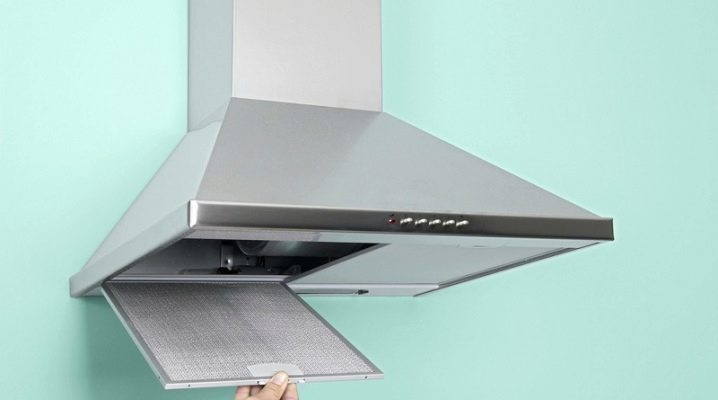
What else do you need to know?
In order not to harm, before starting to wash the hood, remember the following rules:
- Do not clean the replaceable grease trap. Even if it does not fall apart during washing, it will be very bad to catch fat later;
- plastic parts must not be boiled;
- the outer parts of the hood must not be rubbed with rigid metal nets and abrasive detergents;
- aluminum filters cannot often be cleaned with alkalis - they gradually destroy the metal;
- it is better to ensure good ventilation during cleaning. So toxic substances will be better weathering, and the unpleasant odor from body fat will leave faster.
Remember, it is better to rinse the filter twice in a week in a soap solution than to get nervous every six months trying to cope with a layer of fat.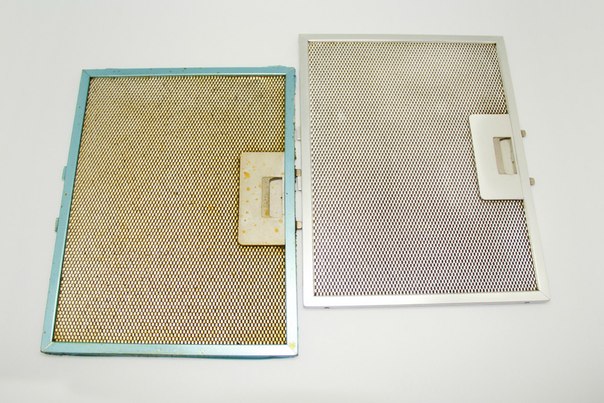

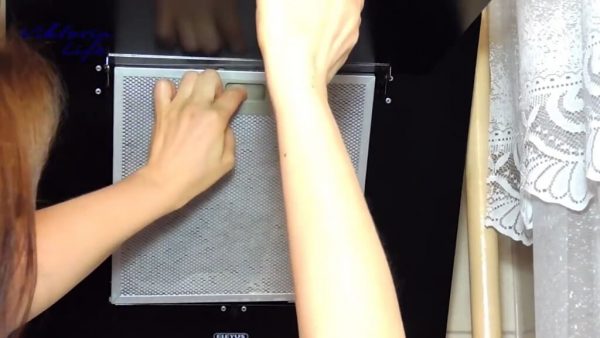
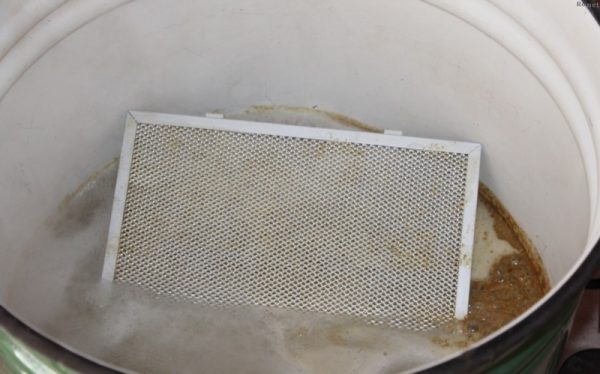
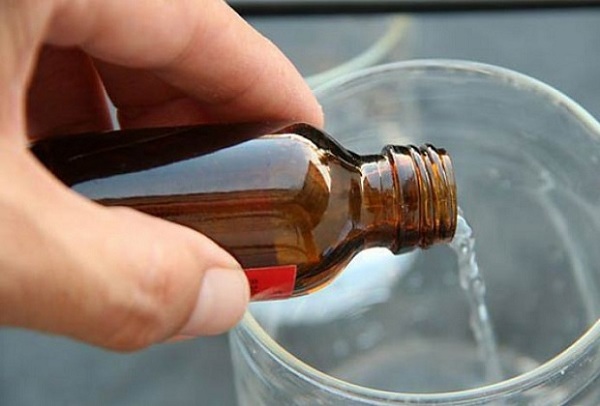
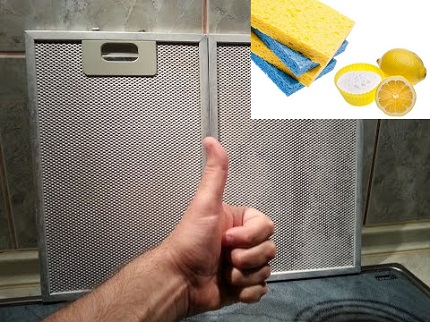
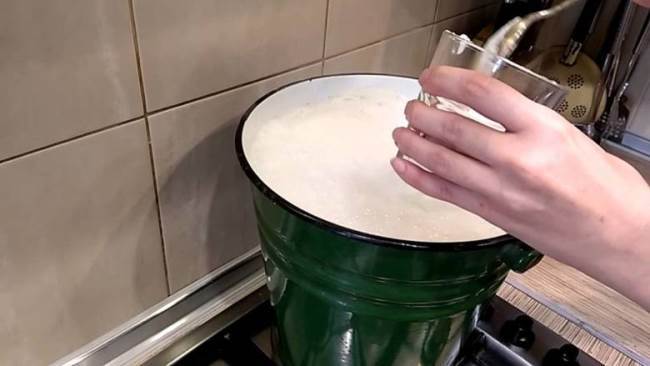
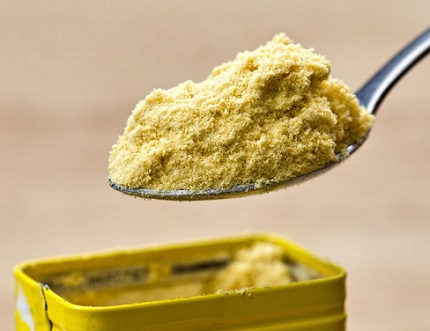
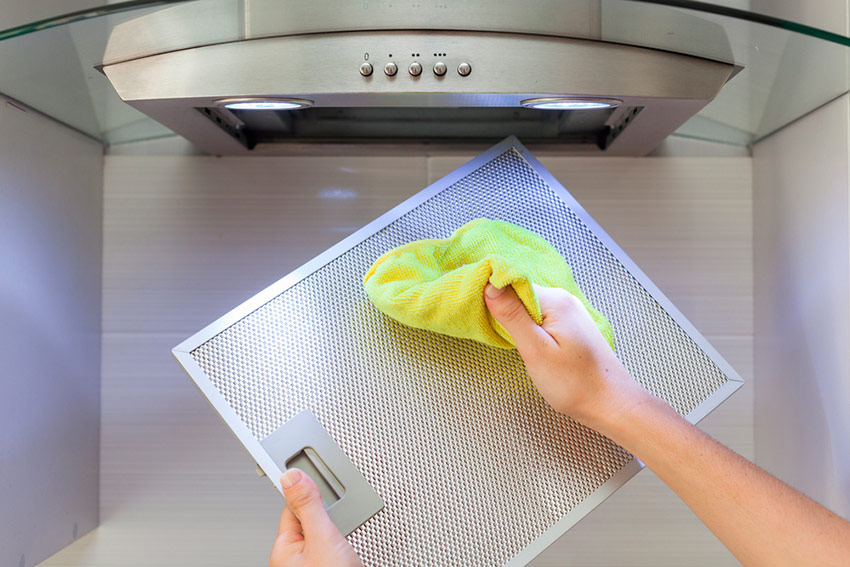
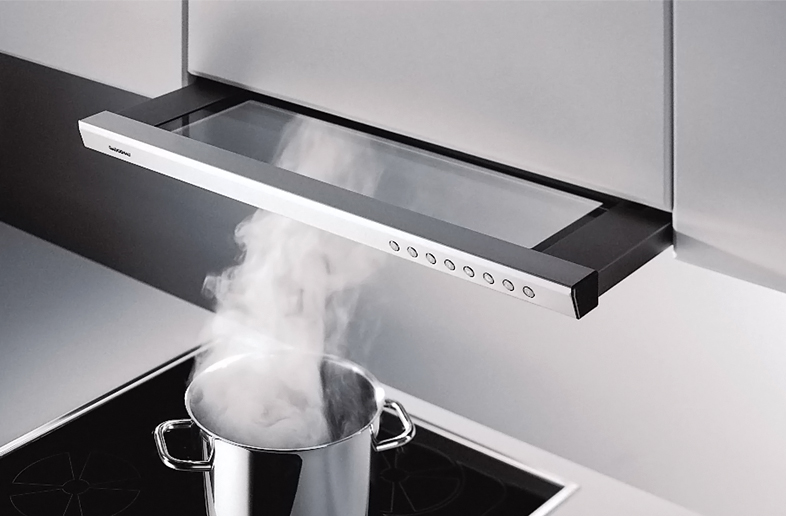
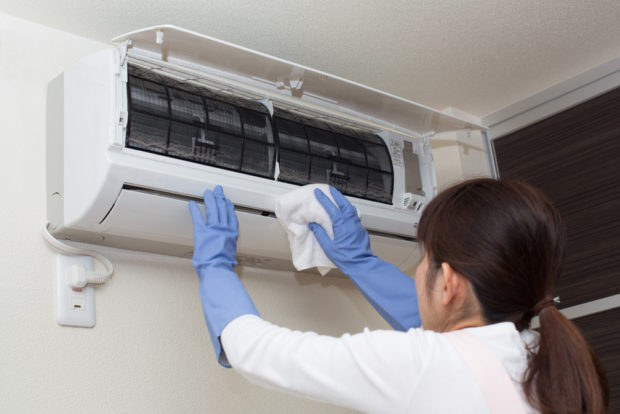
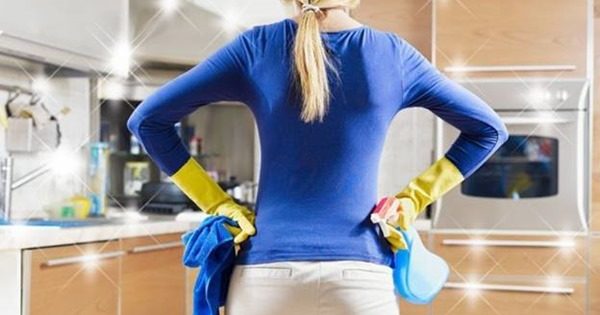
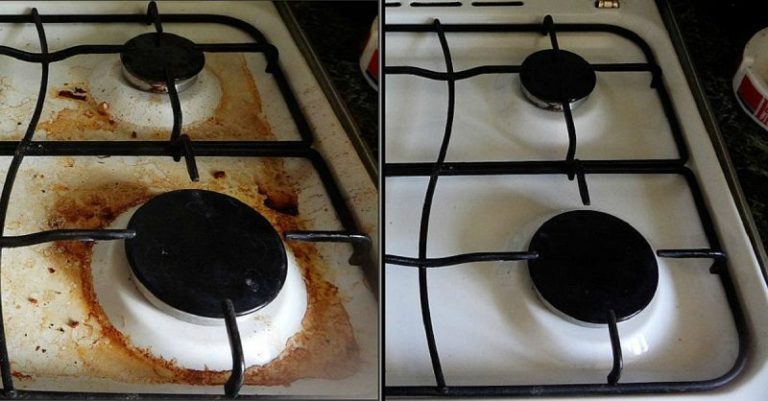
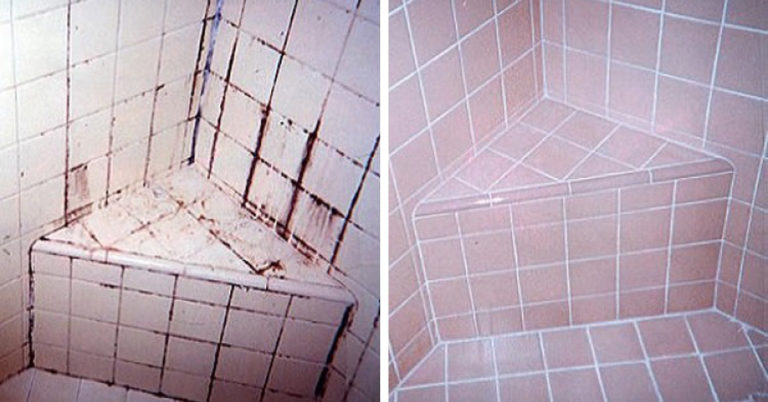
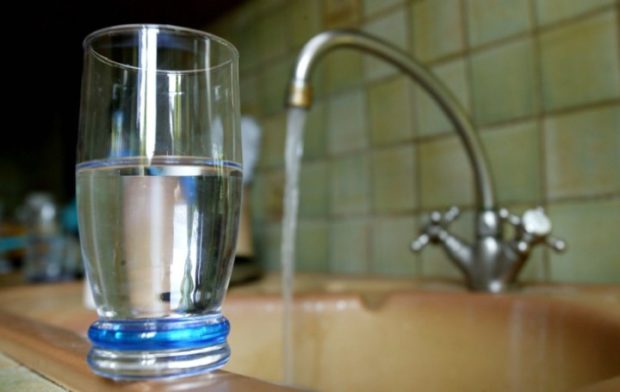
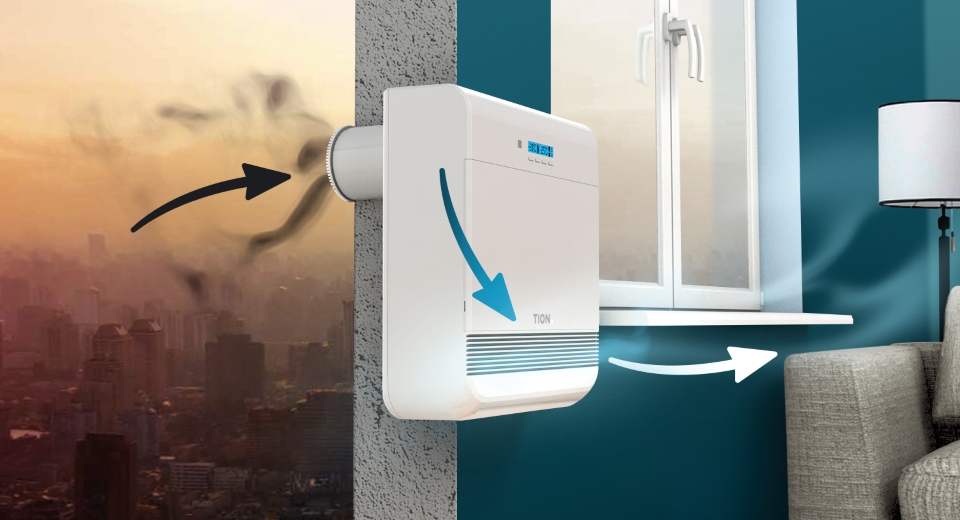
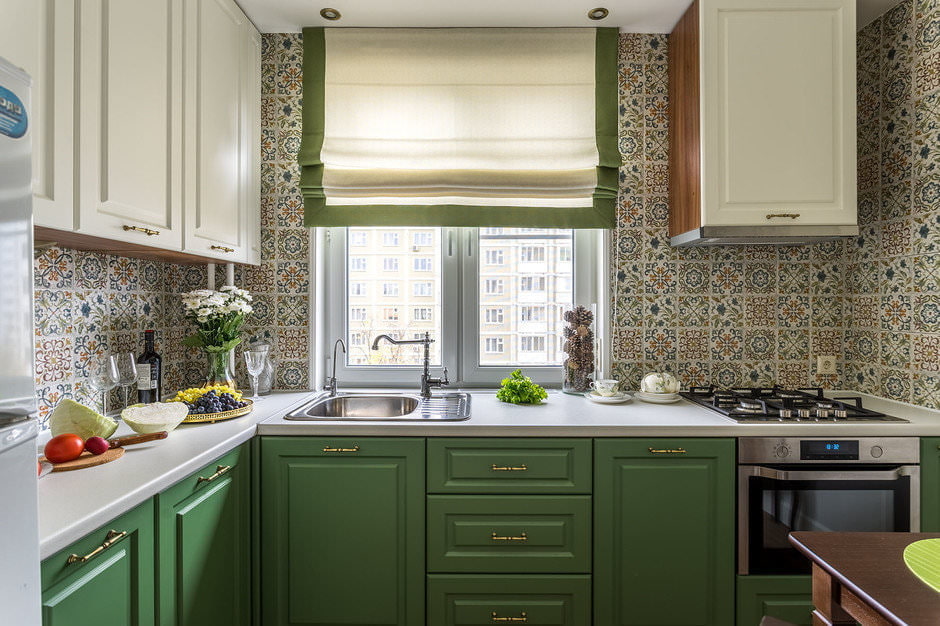
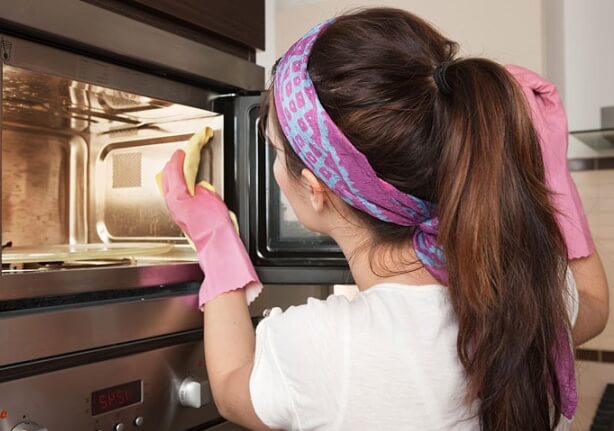

wow, how many popular options, so to speak)))) I will mean if our steam generator breaks down suddenly. in the meantime, I will clean our hot-exhaust hood for them, it’s very convenient